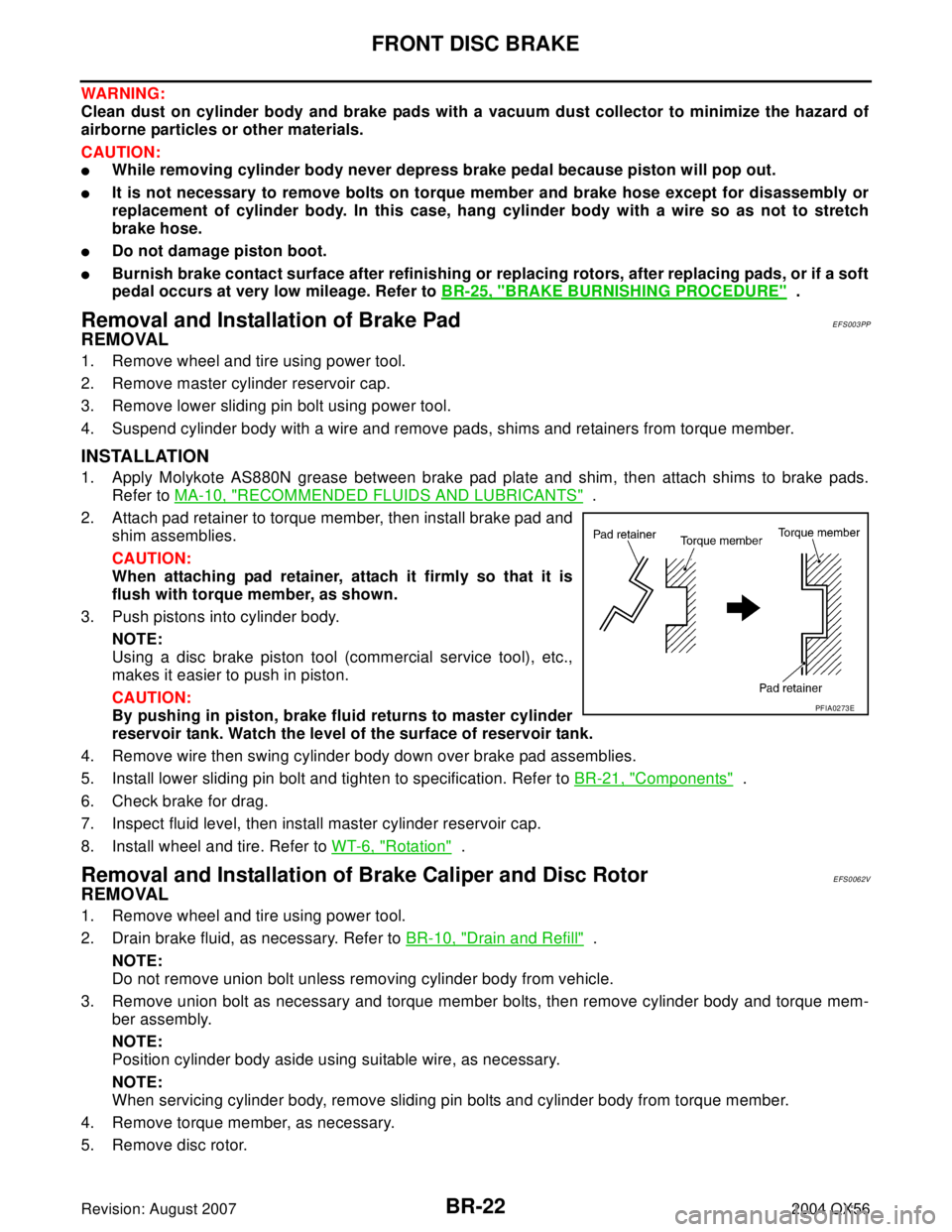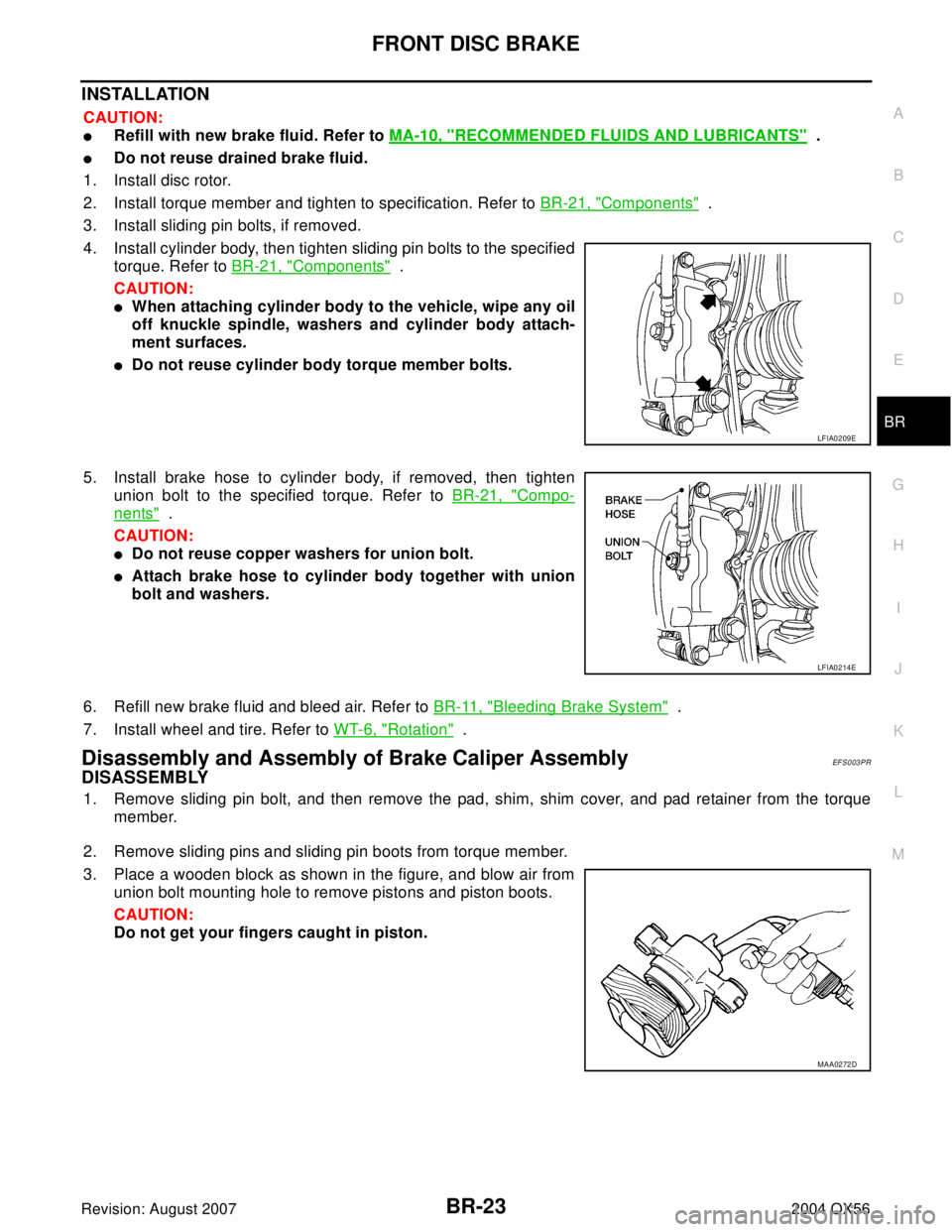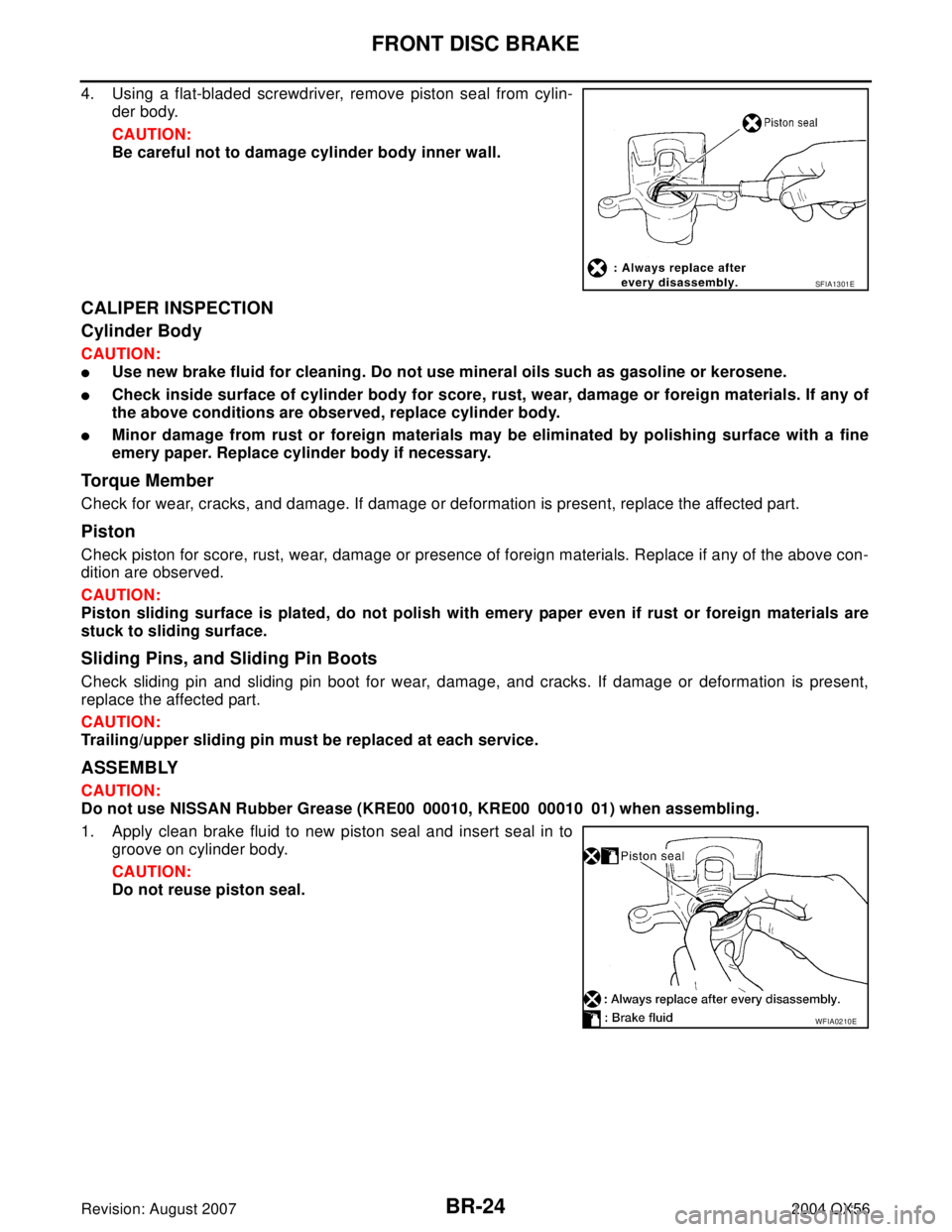Page 978 of 3371
BODY REPAIR
BL-213
C
D
E
F
G
H
J
K
L
MA
B
BL
Revision: August 20072004 QX56
�Weld part to be butt-welded and seam-welded corner to corner as shown in the figure.
LIIA1089E
Page 979 of 3371
BL-214
BODY REPAIR
Revision: August 20072004 QX56
Page 989 of 3371

BR-10
BRAKE FLUID
Revision: August 20072004 QX56
BRAKE FLUIDPFP:KN100
On-board InspectionEFS003P9
LEVEL CHECK
�Make sure the fluid level in reservoir tank is within the standard
(between MAX and MIN lines).
�Visually check around reservoir tank for fluid leaks.
�If fluid level is excessively low, check brake system for leaks.
�If brake warning lamp remains illuminated after parking lever is
released, check brake system for fluid leakage.
Drain and RefillEFS003PA
CAUTION:
�Refill with recommended brake fluid. Refer to MA-10, "RECOMMENDED FLUIDS AND LUBRI-
CANTS" .
�Do not reuse drained brake fluid.
�Do not let brake fluid splash on the painted surfaces of the body. This might damage the paint, so
when splashing it, immediately wipe off the area and wash away with water.
�Before servicing, disconnect actuator connector or battery negative cable.
1. Connect a vinyl tube to each bleed valve.
2. Depress brake pedal, loosen each bleed valve, and gradually
remove brake fluid.
3. Make sure there is no foreign material in reservoir tank, and refill
with new brake fluid.
4. Rest foot on brake pedal. Loosen bleed valve. Slowly depress
pedal until it stops. Tighten bleed valve. Release brake pedal.
Repeat this process a few times, then pause to add new brake
fluid to master cylinder. Continue until new brake fluid flows out.
Bleed air from brake system. Refer to BR-11, "
Bleeding Brake
System" .
LFIA0225E
SBR4 19 C
SBR9 95
Page 995 of 3371

BR-16
BRAKE MASTER CYLINDER
Revision: August 20072004 QX56
INSTALLATION
�Installation is in the reverse order of removal.
�Refill brake fluid and bleed air. Refer to BR-11, "Bleeding Brake System" .
CAUTION:
�Refill with recommended brake fluid. Refer to MA-10, "RECOMMENDED FLUIDS AND LUBRI-
CANTS" .
�Do not reuse drained brake fluid.
�Adjust brake pedal. Refer to BR-7, "ADJUSTMENT" .
Disassembly and AssemblyEFS003PI
DISASSEMBLY
CAUTION:
�Master cylinder cannot be disassembled.
�Remove reservoir tank only when absolutely necessary.
Pull reservoir tank off master cylinder sub-assembly, then remove grommets from master cylinder sub-assem-
bly body.
ASSEMBLY
CAUTION:
�Never use mineral oil such as kerosene, gasoline during the cleaning and assembly process.
�Do not drop parts. If a part is dropped, do not use it.
1. Apply brake fluid or rubber grease to new grommets, then insert into master cylinder sub-assembly. Refer
to GI-45, "
RECOMMENDED CHEMICAL PRODUCTS AND SEALANTS" .
CAUTION:
Do not reuse grommet.
2. Install reservoir tank onto master cylinder sub-assembly.
Page 1000 of 3371
FRONT DISC BRAKE
BR-21
C
D
E
G
H
I
J
K
L
MA
B
BR
Revision: August 20072004 QX56
FRONT DISC BRAKEPFP:41000
On-vehicle InspectionEFS003PN
PAD WEAR INSPECTION
�Inspect the thickness of pad through cylinder body inspection
hole. Use a scale for inspection if necessary.
ComponentsEFS003PO
Standard thickness : 11.88 mm (0.468 in)
Repair limit thickness : 1.0 mm (0.039 in)
BRA0010D
1. Upper sliding pin 2. Sliding pin boot 3. Torque member bolt
4. Torque member 5. Piston seal 6. Piston
7. Inner pad 8. Pad retainer 9. Outer pad
10. Piston boot 11. Union bolt 12. Copper washer
13. Sliding pin bolt 14. Bleed valve 15. Cylinder body
16. Cap 17. Brake hose 18. Lower sliding pin
WFIA0393E
Page 1001 of 3371

BR-22
FRONT DISC BRAKE
Revision: August 20072004 QX56
WAR NIN G:
Clean dust on cylinder body and brake pads with a vacuum dust collector to minimize the hazard of
airborne particles or other materials.
CAUTION:
�While removing cylinder body never depress brake pedal because piston will pop out.
�It is not necessary to remove bolts on torque member and brake hose except for disassembly or
replacement of cylinder body. In this case, hang cylinder body with a wire so as not to stretch
brake hose.
�Do not damage piston boot.
�Burnish brake contact surface after refinishing or replacing rotors, after replacing pads, or if a soft
pedal occurs at very low mileage. Refer to BR-25, "
BRAKE BURNISHING PROCEDURE" .
Removal and Installation of Brake PadEFS003PP
REMOVAL
1. Remove wheel and tire using power tool.
2. Remove master cylinder reservoir cap.
3. Remove lower sliding pin bolt using power tool.
4. Suspend cylinder body with a wire and remove pads, shims and retainers from torque member.
INSTALLATION
1. Apply Molykote AS880N grease between brake pad plate and shim, then attach shims to brake pads.
Refer to MA-10, "
RECOMMENDED FLUIDS AND LUBRICANTS" .
2. Attach pad retainer to torque member, then install brake pad and
shim assemblies.
CAUTION:
When attaching pad retainer, attach it firmly so that it is
flush with torque member, as shown.
3. Push pistons into cylinder body.
NOTE:
Using a disc brake piston tool (commercial service tool), etc.,
makes it easier to push in piston.
CAUTION:
By pushing in piston, brake fluid returns to master cylinder
reservoir tank. Watch the level of the surface of reservoir tank.
4. Remove wire then swing cylinder body down over brake pad assemblies.
5. Install lower sliding pin bolt and tighten to specification. Refer to BR-21, "
Components" .
6. Check brake for drag.
7. Inspect fluid level, then install master cylinder reservoir cap.
8. Install wheel and tire. Refer to WT-6, "
Rotation" .
Removal and Installation of Brake Caliper and Disc RotorEFS0062V
REMOVAL
1. Remove wheel and tire using power tool.
2. Drain brake fluid, as necessary. Refer to BR-10, "
Drain and Refill" .
NOTE:
Do not remove union bolt unless removing cylinder body from vehicle.
3. Remove union bolt as necessary and torque member bolts, then remove cylinder body and torque mem-
ber assembly.
NOTE:
Position cylinder body aside using suitable wire, as necessary.
NOTE:
When servicing cylinder body, remove sliding pin bolts and cylinder body from torque member.
4. Remove torque member, as necessary.
5. Remove disc rotor.
PFIA0273E
Page 1002 of 3371

FRONT DISC BRAKE
BR-23
C
D
E
G
H
I
J
K
L
MA
B
BR
Revision: August 20072004 QX56
INSTALLATION
CAUTION:
�Refill with new brake fluid. Refer to MA-10, "RECOMMENDED FLUIDS AND LUBRICANTS" .
�Do not reuse drained brake fluid.
1. Install disc rotor.
2. Install torque member and tighten to specification. Refer to BR-21, "
Components" .
3. Install sliding pin bolts, if removed.
4. Install cylinder body, then tighten sliding pin bolts to the specified
torque. Refer to BR-21, "
Components" .
CAUTION:
�When attaching cylinder body to the vehicle, wipe any oil
off knuckle spindle, washers and cylinder body attach-
ment surfaces.
�Do not reuse cylinder body torque member bolts.
5. Install brake hose to cylinder body, if removed, then tighten
union bolt to the specified torque. Refer to BR-21, "
Compo-
nents" .
CAUTION:
�Do not reuse copper washers for union bolt.
�Attach brake hose to cylinder body together with union
bolt and washers.
6. Refill new brake fluid and bleed air. Refer to BR-11, "
Bleeding Brake System" .
7. Install wheel and tire. Refer to WT-6, "
Rotation" .
Disassembly and Assembly of Brake Caliper AssemblyEFS003PR
DISASSEMBLY
1. Remove sliding pin bolt, and then remove the pad, shim, shim cover, and pad retainer from the torque
member.
2. Remove sliding pins and sliding pin boots from torque member.
3. Place a wooden block as shown in the figure, and blow air from
union bolt mounting hole to remove pistons and piston boots.
CAUTION:
Do not get your fingers caught in piston.
LFIA0209E
LFIA0214E
MAA0272D
Page 1003 of 3371

BR-24
FRONT DISC BRAKE
Revision: August 20072004 QX56
4. Using a flat-bladed screwdriver, remove piston seal from cylin-
der body.
CAUTION:
Be careful not to damage cylinder body inner wall.
CALIPER INSPECTION
Cylinder Body
CAUTION:
�Use new brake fluid for cleaning. Do not use mineral oils such as gasoline or kerosene.
�Check inside surface of cylinder body for score, rust, wear, damage or foreign materials. If any of
the above conditions are observed, replace cylinder body.
�Minor damage from rust or foreign materials may be eliminated by polishing surface with a fine
emery paper. Replace cylinder body if necessary.
Torque Member
Check for wear, cracks, and damage. If damage or deformation is present, replace the affected part.
Piston
Check piston for score, rust, wear, damage or presence of foreign materials. Replace if any of the above con-
dition are observed.
CAUTION:
Piston sliding surface is plated, do not polish with emery paper even if rust or foreign materials are
stuck to sliding surface.
Sliding Pins, and Sliding Pin Boots
Check sliding pin and sliding pin boot for wear, damage, and cracks. If damage or deformation is present,
replace the affected part.
CAUTION:
Trailing/upper sliding pin must be replaced at each service.
ASSEMBLY
CAUTION:
Do not use NISSAN Rubber Grease (KRE00 00010, KRE00 00010 01) when assembling.
1. Apply clean brake fluid to new piston seal and insert seal in to
groove on cylinder body.
CAUTION:
Do not reuse piston seal.
SFIA1301E
WFIA0210E